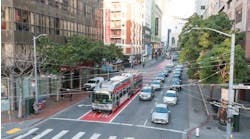High-speed rail could spur economic growth in major cities, protect the environment, and save energy — but requires a fresh approach that creates new, accountable rail management structures,brings in the private sector, and concentrates for now on California and the Northeast, according to a new report published by the Lincoln Institute of Land Policy.
High-Speed Rail: International Lessons for U.S. Policy Makers, the Lincoln Institute's latest Policy Focus Report, applies 50 years of international experience in high-speed rail to the United States context, and recommends prioritizing corridors with demonstrated markets, such as the Northeast and California, and exploring alternative management and financing arrangements including separating infrastructure development from rail operations and forming public-private partnerships.
The report, released today at an event one block from Boston's South Station, also recommends that high-speed intercity stations should be in city centers with mixed-use development all around them, and have abundant connections to buses, subways and commuter rail, allowing passengers to reach final destinations and broadening access to labor markets.
Decades of experience in Europe and Asia shows that high-speed rail can create real value, and that it would provide similar benefit in the United States. Around the world, nations in Asia and Europe have been building high-speed rail lines with trains capable of reaching 185 miles per hour and more. China alone has built 4,000 miles of track and has 300 million riders. In the United States, spending on highways and aviation has dominated; the Obama administration has invested $10 billion in rail investments nationwide, but the initiative ran into political opposition, and Congress recently voted to strip future funding. Nevertheless, California is moving ahead with a high-speed line, and the Boston-Washington corridor, including the Acela service, is one of the most popular, competing well with airlines.
High-Speed Rail: International Lessons for U.S. Policy Makers, by Petra Todorovich, director of America 2050, a joint venture project of the Lincoln Institute and the Regional Plan Association, and co-authors Dan Schned and Robert Lane, both from RPA, makes the following policy recommendations to make planning, constructing and operating high-speed rail a success:
- Strengthen the federal policy and management framework by expanding the federal role in planning and prioritizing high-speed rail corridors and working with the states to secure rights-of-way.
- Focus initially on the Northeast Corridor and California, which offer the best opportunities for success, by addressing the management and financing challenges each region faces
- Establish new mechanisms for corridor management by developing legislation that enables the creation of public infrastructure corporations that can operate across state and national borders and attract private investment.
- Plan for maximum land development benefits by coupling high-speed rail station investments with policies that encourage land development around station areas. Well-connected stations in center-city locations offer the greatest potential for urban revitalization.
- Secure adequate and reliable funding by drawing on a full complement of potential federal, state and private sources. Such sources could include increasing existing transportation related fees - such as a portion of the gas tax, or ticket surcharges — creating an infrastructure bank, forging public-private partnerships, and expanding existing credit assistance programs.
The report suggests a blend of federal planning and oversight in partnership with states, which are implementing high-speed and conventional passenger rail projects. In multi-state corridors like the Northeast, it recommends the creation of federally chartered infrastructure corporation that can finance infrastructure development with public private partnerships. Passenger rail operators, such as Amtrak and other competing carriers, would pay track access fees to run their trains on the lines.
The international experience with high-speed rail suggests that similar transportation, economic, environmental and safety benefits would apply in American cities and regions. While it requires high upfront investment, high-speed rail promotes economic growth by improving market access, boosting productivity of knowledge workers, expanding labor markets, and attracting visitor spending. When planned thoughtfully with complementary investments in the public realm, high-speed rail can promote urban regeneration and attract commercial development, as shown in several European examples. High-speed rail has greater operating energy efficiency than competing modes and takes up less land than highways.
The Lincoln Institute of Land Policy has been engaged in a series of projects with the Regional Plan Association for more than a decade. The partnership spawned the national initiative known as America 2050, which is aimed at meeting the infrastructure, economic development and environmental challenges of the nation, in preparation for a population increase of more than 100 million by 2050. A major focus of America 2050 is the emergence of megaregions — networks of adjacent metropolitan areas, where most of the population growth by mid-century will take place. Examples of megaregions are the Northeast Megaregion, from Boston to Washington, or Southern California, from Los Angeles to Tijuana, Mexico. High-speed rail is capable of linking employment centers and population hubs in corridors up to 600 miles in length in 11 U.S. megaregions.

